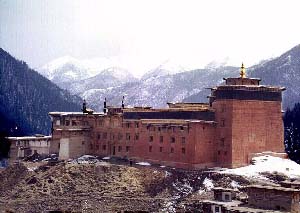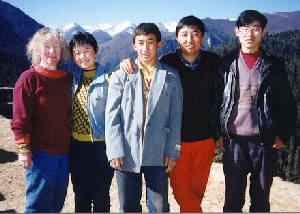In April and May of 1998 I visited Palpung Gonpa three times, inspected the ongoing repairs, and sent an art conservation team to rescue some precious wall paintings. The mural work was unplanned, a spur-of-the-moment decision motivated by urgent need. Here's how it happened.
 |
| Palpung, April 1998. Murals located in damaged section at upper right. |
The main purpose of the field mission was to finish art conservation work at nearby Baiya Monastery, and I arrived there on April 9th with four foreign conservators, five Tibetan apprentices, and a slew of support personnel. After the work was smoothly underway, I was able to slip out for a visit to Palpung, which is now connected to Baiya by a dirt road that takes about 1 1/2 hours to drive. Riding in the back of a truck up the long, steep approach, I reached the immense fortress of Palpung's main temple.
No matter how many times I visit, I'm always astonished at the size of the place. The thick rammed-earth walls are looking worse every year, as wind and rain erodes them, and cracks slowly widen. Inside the temple was a hodgepodge of new wood and old, the upper part of the assembly hall sliding southward, tilted walls still tilted and their angles gradually steepening, fresh timber and clay poked into the breaches to stave off gradual, inexorable collapse.
The most urgent part of the building is the highest part of the temple, a hall that houses a 20-meter high Maitreya statue. The roof and upper walls of this chamber are getting ready to come crashing down. Within this hall is a small balcony whose front upper wall is decorated with eight painted images. They are round depictions of Bodhisattvas, about one meter in diameter. "They were made by the previous incarnation of Situ Rinpoche," Xiong Xiong told me. "One night he had a dream, and when he woke up he came here and began painting. These murals are very important to the monastery," he continued. "Can you please, please find a way to save them?"
At that time, I thought we had no spare manpower or time to work on Palpung's murals. I
was considering how I could include art conservators for Palpung on my next mission, when
Xiong Xiong interrupted my thoughts. "The work has got to be done next month at the
latest," he said. "If you can't do it, then please leave behind some tools and
materials, and we'll do it ourselves."
 |
| Yang Jin prepares a mural for detachment by applying fixative to protect the color. |
His was a gallant gesture, but I knew that if an untrained person tried to detach the
paintings from their underlying clay wall, the results could be disastrous. At least these
murals are not as valuable as Baiya's, I thought When Italian experts Donatella Zari and
Carlo Giantomassi were here three years ago, they put the paintings at about 50 years old,
which makes them babies compared to the 270-year-old murals at Baiya. We would have to
take care of Baiya first. Then I would see if there was any chance to help Palpung.
I returned to Baiya, and watched the work continue. There was plenty of it, and the conservation team labored hard all day, every day. Nevertheless, I asked Donatella whether we might be able to send a small party out to Palpung. She looked at our supplies, equipment, and manpower, and decided that American conservator Karen Yager and our top apprentice Yang Jin could be spared, along with three others to help them. Dona told me what Yang Jin would have to do: "First she has to clean, then she has to fix the paintings, by putting paraloid and vinavyl on the wall. Before she goes to sleep she has to put the glue in the water." Dona counted the days on her fingers. "First glue. One day later, second glue. It means five days."
We could do it! Quickly, I dispatched a message to Palpung's abbot, offering the services of my team. A few days later some envoys arrived with a confusing reply. The murals aren't so valuable, they said; really you needn't bother. The journey will be so hard for your people. Besides, the wall has already fallen down.
We were nonplused. Already fallen down? It couldn't be. I was there only one week earlier and saw them myself! How could it have happened so quickly? As we were digesting this incomprehensible reply, the Palpung monks got back into their car and sped away. But still I couldn't stop thinking. Were they just angry that I hadn't done more to help repair the building? It might be one of those inscrutable Oriental tantrums. A day or two later I sent a message to Palpung's abbot, countering all the obfuscation. In the end, we won a grudging invitation to come and save Situ Rinpoche's murals.
The Palpung rescue mission was on. The five chosen ones departed, along with suitable amounts of food and conservation materials. Karen Yager later reported, "They are amazingly sensitive and fine pieces...painted with mineral pigments that were hardly bound at all; when we tried to clean them they lifted right off like pastels. So cleaning was inappropriate." With that minor change of procedure, the work had been swiftly done. When I arrived on the fifth day, all that remained were three paintings covered with gauze and glue and ready to be detached. They had been saved for the three new apprentices I had brought with me.
When the last painting was lifted away from the wall, everyone raise their hands in a
victory salute. We did it!
 |
| Palpung mural rescue team: (left to right) Karen Yager, Deshi Yangjin, Trajia, Denba Daji, Wu Bangfu. |
As the final painting was being carried downstairs, Xiong Xiong's carpenters were already building a protective covering for the gigantic Maitreya statue, in preparation for demolition of the damaged roof. Our rescue came not a moment too soon. Now the paintings will wait in storage until building repairs are complete and a team can come back out to return the murals to their original places..
As for the rest of Palpung, I don't know what the future holds. Whenever the monastery gets its hands on some money, they have Xiong Xiong replace more damaged timbers. Parts of the roof have been remade, and new masonry appears at the grand entrance, beneath the columns, and buttressing the structure's base. But a number of potentially devastating problems still afflict the building--problems that Xiong Xiong, for all his skill, has no experience in solving. The walls become thinner every year as the outside erodes, and big cracks might cause the building to fall apart at the next earthquake. Until more funds and expert assistance arrive, the monastery's future will be in doubt.